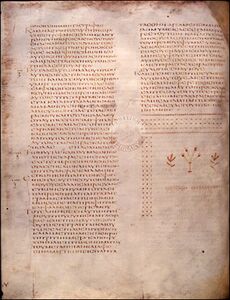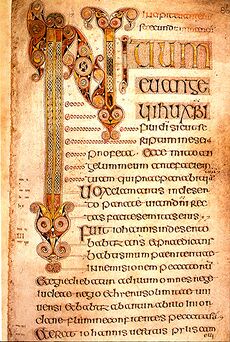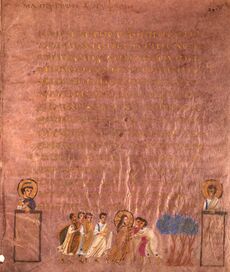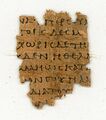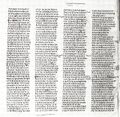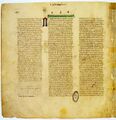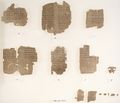مخطوطات الكتاب المقدس
| جزء من سلسلة عن |
| الكتاب المقدس |
|---|
|
Outline of Bible-related topics |
. . . . . . . . . . . . . . . . . . . . . . . . . . . . . . . . . . . . . . . . . . . . . . . . . . . . . . . . . . . . . . . . . . . . . . . . . . . . . . . . . . . . . . . . . . . . . . . . . . . . . . . . . . . . . . . . . . . . . . . . . . . . . . . . . . . . . . . . . . . . . . . . . . . . . . . . . . . . . . . . . . . . . . . .
ما هي المخطوطة ، وما هي فائدتها لنا اليوم ؟
المخطوطة تعني الوثيقة التي دونت بخط اليد ، سواء كانت كتابة ، أو بالحفر ( أي النقش ) .. لذا تسمى مخطوطة ، وجمعها مخطوطات . وأما بخصوص مخطوطات الكتاب المقدس ؛ فإنه يعلم كل من درس شيئاً عن المخطوطات القديمة أن هناك آلافاً من المخطوطات القديمة سواء كانت للعهد القديم أو للعهد الجديد أو الكتاب المقدس بكامله . وهذه المخطوطات موجودة في مختلف متاحف العالم الشهيرة . والاكتشافات الحديثة لبعض المخطوطات تعطينا مزيداً من اليقين بشأن صحة الكتاب المقدس كما هو بين أيدينا اليوم . والذي يقارن بين مخطوطات الكتاب المقدس القديمة ، ومخطوطات بعض الكتابات الكلاسيكية القديمة أيضاً ، مثل كتابات هوميروس وما إلى ذلك ، يدهشه حقاً أن يرى توافقاً كبيراً بين مخطوطات الكتاب المقدس ، بينما تظهر اختلافات كثيرة بين مخطوطات سائر تلك الكتابات الأخرى رغم ما تحظى به من شهرة عالمية كبيرة
كيف يحدد العلماء تاريخ المخطوطات بدقة ؟
يستطيع العلماء أن يحددوا تاريخ المخطوطات المختلفة بدقة عن طريق استخدام جهاز خاص لذلك يقوم بتحليل الحبر أو المادة المكتوب عليها وفحص ما يسمى بالكربون المشع أو الكربون رقم 13 كما يمكن التعرف على تاريخ كتابة المخطوطات من نوع الخط المكتوب به كالكوفي والكوفي المعدل والنسخ في اللغة العربية ، وفي الكتابة بحروف منفصلة أو حروف متصلة في المخطوطات اليونانية ، وما إلى ذلك
- ومخطوطات الكتاب المقدس الموجودة بين أيدينا اليوم تعود في تاريخ نقلها عن مخطوطات سابقة إلى سنوات قريبة جداً من تاريخ كتابة نسخها الأصلية كما سيليبيانه ، بينما نجد أن أقدم مخطوطات كتابات أفلاطون مثلاً تعود إلى 1300 سنة بعد وفاته . ولا توجد مخطوطة لكتابات ديموشين أقدم من 1200 سنة بعد وفاته . وبينما دون تاسيتوس أربعة عشر كتاباً في " التاريخ " عام 1.. ميلادية تقريباً ، لا يوجد لدينا اليوم منها سوى مخطوطات أربعة كتب ونصف ، يعود أقدمها للقرن التاسع الميلادي ! يوجد لدينا اليوم أكثر من عشرة آلاف مخطوطة للكتاب المقدس أو أحد أجزائه ،
ماذا تخبرنا المخطوطات عن الكتاب المقدس؟
بكل تأكيد تخبرنا هذه المخطوطات بقدم الكتاب المقدس ، وأصالته ، وأيضاً بعدم تحريفه . وإذا تأملنا تواريخها لوجدنا بأن البعض منها يرجع إلى زمن يسبق من يقولون بتحريفها . وإليك عرض لبعض هذه المخطوطات
أولاً: شهادة المخطوطات للعهد الجديد
. يقول أ. ت . روبرتس مؤلف أقوى كتاب في قواعد اللغة اليونانية للعهد الجديد : أنه يوجد نحو عشرة آلاف مخطوطة للفولجاتا اللآتينية ، وعلى الأقل ألف مخطوطة من الترجمات القديمة ، ونحو 5,3.. مخطوطة للعهد الجديد بكامله ، كما يوجد لدينا اليوم 24 ألف مخطوطة لأجزاء من العهد الجديد ، كما أننا نقدر أن نجمع أجزاء كثيرة من العهد الجديد من إقتباسات الكتاب المسيحيين الأولين
وإليك أسماء وتواريخ بعض المخطوطات :
مخطوطة جون رايلاند(RYLAND) ( 130 م )
فى مكتبة مانشستر بإنجلترا وهى أقدم المخطوطات ، وقد وجدت في مصر .بها إنجيل يوحنا ، مع أن المعروف أن هذا الإنجيل كتب في أسيا الصغرى . وهى تؤكد أن الإنجيل كتب حوالى نهاية القرن الأول الميلادى
. مخطوطات تشسترى بيتى (CHESTER BEATTY PAPYRI ) ( 200 م )
موجودة في متحف بيتى في دبلن ، وجزء منها في جامعة ميتشجان .. وهى من ورق البردى ، وتحتوى ثلاثة منها على معظم العهد الجديد . وهى أقرب المخطوطات إلى النص الأصلى من جهة تاريخية
بردية بدمر ( BODMER ) ( 150 - 200 م )
موجودة بمكتبة بدمر وتحوى معظم إنجيل يوحنا ، وهى أهم مخطوطة بعد مخطوطات تشستر بيتى ، وكثيرون من العلماء يرجعون بتاريخها إلى منتصف القرن الثانى ، إن لم يكن إلى النصف الأول منه
النسخة الفاتيكانية ( CODEX VATICNUS ) (325 -350 م )
موجودة في مكتبة الفاتيكان وتحوى كل الكتاب المقدس تقريباً ، وهى من أثمن مخطوطات الكتاب المقدس بباليونانية
النسخة السينائية ( CODEX SINAITICUS ) ( 350 م )
موجودة في المتحف البريطانى ، وتحوى كل العهد الجديد ما عدا ( مرقس 16: 9- 2. ، يوحنا 7: 53- 8: 11)كما تحوى
أكثر من نصف العهد القديم . وقد عثر عليها تشندروف في سلة للمهملات في دير جبل سيناء عام 1844 م ، وسلمها الدير هدية لقيصر روسيا عام 1859 م وإشترتها الحكومة البريطانية من الإتحاد السوفيتى بمائة ألف جنيه يوم عيد الميلاد سنة 1933 م
النسخة الأسكندرية ( CODEX ALEXANDRINUS ) ( 400 م )
بالمتحف البريطانى ، وتقول الموسوعة البريطانية أنها المخطوطات القديمة ، وتحوى كل الكتاب المقدس تقريباً
وهذه المخطوطات القديمة ، وغيرها كثير ، تطهر :
(أ) أن مخطوطات الكتاب المقدس أكثر جداً من مخطوطات أى كتاب قديم آخر
(ب) أن تاريخ المخطوطات الموجودة عندنا قريب جداً من تاريخ كتابة النص الأصلى ، إذا قارنا ذلك بأى مخطوطة أخرى لأى كتاب قديم
ويقول العلامة ف ز هورت الذى قضى 28 سنة في دراسة نصوص العهد الجديد : " إن الكثرة من مخطوطات العهد الجديد والتى يعود الكثير منها إلى العصور الأولى التى تكاد تتصل بتاريخ كتابة النص الأصلى ، تجعل نص العهد الجديد يقف فريداً بين كل الكتابات الكلاسيكية القديمة ، ولا تدانيه في ذلك أى كتابات أخرى "
مخطوطات العهد القديم (تناخ) وحده
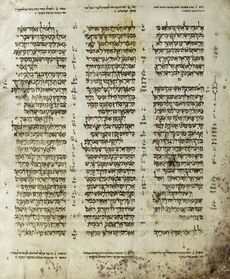
- يرجع تاريخ أقدم مخطوطة للعهد القديم إلى القرن الأول الميلادي أو ربما القرن الثاني ، وهي جزء من مخطوطة مطكتوبة على ورق البردى تُعرف باسم " بردية ناش " وتشمل الوصايا العشر كما نجدها في الإصحاح الخامس من سفر التثنية ، وكذلك : " اسمع يا إسرائيل ... " ( سفر التثنية ، الإصحاح السادس ، والآيات من 4 – 6 ، وهي التي بمثابة إقرار إيمان شعب الله القديم . كما عثر أيضاً على أجزاء كثيرة من العهد القديم ، والتي يعود بعضها إلى القرن الخامس الميلادي التي اكتشفت في مجمع اليهود بحي مصر القديمة بالقاهرة . على أن أهم المخطوطات ذات الشأن التي كانت بين أيدينا قبل اكتشاف مخطوطات البحر الميت عام 1947 هي ما يلي
- مجلد القاهرة Cairo Codex الذي اكتشف في مجمع اليهود بمصر القديمة بالقاهرة ويشمل كتابات الأنبياء وتاريخ كتابته سنة 895 ميلادية
- مجلد ليننجراد الخاص بالأنبياء ويشمل نبؤات أشعياء وأرمياء وحزقيال والأنبياء الصغار الاثني عشر ، وتم نسخه عام 916 ميلادية
- مجلد حلب الذي يشمل العهد القديم بكامله وتاريخ كتابته 925 ميلادية
- مجلد المتحف البريطاني وهو يشمل الكتب الخمسة الأولى وتاريخه 95. ميلادية
- مجلد روشلين الذي يشمل الأنبياء ، وقد تم نسخ هذا المجلد عام 1105 ميلادية
- مجلد ليننجراد الذي تم نسخه عام 1108 ميلادية ، ويشمل العهد القديم كله
وهناك أيضاً بردية ترجمة يونانية لحوالي خمس عشرة آية من سفر التثنية تعود بنا إلى القرن الثاني الميلادي وهي موجودة في مكتبة جون رايلاندز في مانشستر بإنجلترا
إلا أن مخطوطات البحر الميت ( قمران ) والتي اكتشفت في منطقة خرائب قمران في الساحل الشمال الشرقي لمدينة القدس ، وضعت بين أيدينا درجين لسفر أشعياء أحدهما يشمل النص كاملاً ، ويعود للقرن الثاني قبل الميلاد ، والدرج الآخر ضاعت بعض أجزائه ، ومعه نص سفر حبقوق وتفسير له . وقد اكتشفت كل هذه في الكهف الأول .ودأب علماء الحفريات والبدو على البحث والتنقيب في هذه المنطقة ما بين سنة 1952 و سنة 1956 واكتشفوا مزيداً من النصوص في عشرة كهوف أخرى فوجدوا في الكهف الحادي عشر 41 مزموراً من المزامير التي بين أيدينا اليوم ، كما اكتشفوا أجزاء من أكثر من مائة درج أخرى تشمل بعض الآيات من كل أسفار العهد القديم ما عدا سفر أستير
وتعود هذه المخطوطات إلى القرنين الأول والثاني قبل الميلاد . ويلاحظ كل من يدرس هذه النصوص أنها تتطابق مع بعضها تطابقاً كاملاً مع النص الموجود بين أيدينا اليوم ، فيما عدا بعض الاختلافات الطفيفة التي يتوقع المرء أن يجدها نتيجة نقل مخطوطة عن مخطوطة أخرى على مدى قرون طويلة
مخطوطات البحر الميت ، وإليك موجز تعريفي عنها هو الاسم الذي يطلق على مجموعة من المخطوطات ترجع في أصلها إلى جماعة دينية قديمة كانت تعيش بالقرب من البحر الميت
الإكتشافات الأولى : لا نعلم على وجه اليقين متى اكتشفت أولى هذه اللفائف ، ولكن الأرجح أن ذلك حدث في سنة 1947 . فقد جال أحد البدو يبحث عن شاته الضالة فدخل إلى أحد الكهوف في المنحدرات العالية في وادي قمران على بعد نحو ميل إلى الغرب من الطرف الشمالي الغربي للبحر الميت . وعلى بعد يزيد قليلاً عن ثمانية أميال إلى الجنوب من أريحا . تعثرت أقدام البدوي في عدة جرار يبلغ إرتفاع الجرة منها أكثر من قدمين ، ونحو عشر بوصات في العرض ، وجد بها رقوقاً من الجلد ملفوفة في نسيج من كتان ، فأخذها من الكهف سراً وذهب بها لأحد محال التحف الأثرية في بيت لحم ، فأشترى البعض منها ، ووصل الباقي إلى يد رئيس دير السريان الأرثوذكسي في أورشليم
وقام عدد من العلماء بفحص اللفائف في 1947 ، وقد ظن البعض في البداية أنها مخطوطات مزيفة ، ولكن أ . ل . سوكنك من الجامعة العبرية بأورشليم ، أثبت أنها مخطوطات أثرية قديمة واستطاع شراء ثلاث منها . ونقلت بعض المخطوطات إلى المعاهد الأمريكية المختصة بالأبحاث الشرقية ، حيث تحقق مديرها مستر ج . تريفر من قيمتها ونجح في تصويرها ، وأرسل بعض صورها إلى و.ف.أولبريت – العالم في الأركيولوجية الكتابية . وقد قرر هذا العالم أن هذه اللفائف تعتبر أهم كشف لمخطوطات العهد القديم ، وهو ما أيدته الأبحاث التالية
وعندما تأيديت أهمية هذه اللفائف ، قامت الحرب بين العرب وإسرائيل في سنة 1948 ، فحالت دون تحديد موقع الكهف الأول والتنقيب فيه تنقيباً علمياً ، وهو ما قام به في 1949 ج.ل.هاردنج من إدارة الأثار الأردنية ، ومستر ى.ديفو من مدرسة التوراة في أورشليم فاستطاعا استعادة مئات القصاصات من المخطوطات الكتابية وغير الكتابية ، والأبوكريفية التي لم يكن بعضها معروفاً من قبل . لقد كان الكهف مستودعاً لمكتبة تتكون من نو مائتي لفافة ، ويحتمل أن الأيدي قد إمتدت إليها من قبل إذا صحت رواية يوسابيوس من أن أوريجانوس استخدم ترجمة يونانية لسفر المزامير وجدت في كهف بالقرب من أريحا . وقد تكون هي نفس المكتبة التي وصفت بأنها " بيتالكتب الصغير " الذي وجده أحد الرعاة بالقرب من أريحا في نحو عام 8.. م ، وبلغ خبره البطريرك النسطوري تيموثاوس الأول
وكانت الحرب الفلسطينية دافعاً إلى نقل اللفائف ، التي كانت في حوزة البطريرك السرياني إلى الولايات المتحدة في 1948 حيث نشرها م.باورز ، ج.تريفر ، و هـ . براونلي . وقد اشتملت هذه اللفائف على لفافة كاملة لنبوة إشعياء ، وتعليق على سفر حبقوق ، ووثيقة أطلق عليها باروز اسم " كتاب النظام " لأنه كان يشتمل على القواعد التي تحكم حياة الجماعة في قمران ولم يمكن في البداية فض إحدى اللفائف التي ظنوا في البداية أنها " سفر لامك " الأبوكريفي ، فلم تفتح اللفافة إلا في 1956 وثبت أنها الإصحاحات الأولى من سفر التكوين بصياغة أخرى وقد نشر في 1956 تحت اسم " التكوين الأبوكريفي "
. أما اللفائف التي حصل عليها أ.ل.سوكنك ، فكانت تشتمل على لفافة غير كاملة لسفر إشعياء ، ومخطوطة عن الحرب ، وأربعة أجزاء من مجموعة من ترانيم الشكر ، وقد نشر كل المجموعة في 1954 ، يادين بن سوكنك – بعد موت أبيه – تحت عنوان :" كنز اللفائف المخبوءة ". كما نشر دكتور بارثلمي ، ج.ت.ميليك القصاصات التي وجدت في الكهف الأول في قمران في 1955 تحت اسم " قمران – الكهف الأول "
ثم تتالت الإكتشافات من عام 1951 وحتى عام 1955 ،
Extant Tanakh manuscripts
| Version | Examples | Language | Date of Composition | Oldest Copy | ||||||
|---|---|---|---|---|---|---|---|---|---|---|
| Ketef Hinnom scrolls | Hebrew written in the Paleo-Hebrew alphabet | c. 650–587 BCE | c. 650–587 BCE[1] (amulets with the Priestly Blessing recorded in the Book of Numbers) | |||||||
| Dead Sea Scrolls | Hebrew, Aramaic, and Greek | c. 150 BCE – 70 CE | c. 150 BCE – 70 CE (fragments) | |||||||
| Septuagint | Codex Vaticanus, Codex Sinaiticus and other earlier papyri | Greek | 300–100 BCE | 2nd century BCE (fragments) 4th century CE (complete) | ||||||
| Peshitta | Syriac | early 5th century CE | ||||||||
| Vulgate | Codex Amiatinus | Latin | early 5th century CE early 8th century CE (complete) | |||||||
| Masoretic | Aleppo Codex, Leningrad Codex and other, incomplete MSS[أ] | Hebrew | c. 100 CE | 10th century CE (complete) | ||||||
| Samaritan Pentateuch | Hebrew | 200–100 BCE | Oldest extant MSS, c. 11th century CE; oldest MSS available to scholars, 16th century CE | |||||||
| Targum | Aramaic | 500–1000 C E | 5th century CE | |||||||
| Coptic | Crosby-Schøyen Codex, British Library MS. Oriental 7594 | Coptic | 3rd or 4th century CE | |||||||
. . . . . . . . . . . . . . . . . . . . . . . . . . . . . . . . . . . . . . . . . . . . . . . . . . . . . . . . . . . . . . . . . . . . . . . . . . . . . . . . . . . . . . . . . . . . . . . . . . . . . . . . . . . . . . . . . . . . . . . . . . . . . . . . . . . . . . . . . . . . . . . . . . . . . . . . . . . . . . . . . . . . . . . .
مخطوطات اشعياء كاملة بالصور
[[1]]
New Testament manuscripts
The New Testament has been preserved in more manuscripts than any other ancient work of literature, with over 5,800 complete or fragmented Greek manuscripts catalogued, 10,000 Latin manuscripts and 9,300 manuscripts in various other ancient languages including Syriac, Slavic, Gothic, Ethiopic, Coptic and Armenian. The dates of these manuscripts range from c. 125 (the 𝔓52 papyrus, oldest copy of John fragments) to the introduction of printing in Germany in the 15th century.[بحاجة لمصدر]
Often, especially in monasteries, a manuscript cache was little more than a former manuscript recycling centre, where imperfect and incomplete copies of manuscripts were stored while the monastery or scriptorium decided what to do with them.[بحاجة لمصدر] There were several options. The first was to simply "wash" the manuscript and reuse it. Such reused manuscripts were called palimpsests and were very common in the ancient world until the Middle Ages. One notable palimpsest is the Archimedes Palimpsest. When washing was no longer an option, the second choice was burning. Since the manuscripts contained the words of Christ, they were thought to have had a level of sanctity;[بحاجة لمصدر] burning them was considered more reverent than simply throwing them into a garbage pit, which occasionally happened (as in the case of Oxyrhynchus 840). The third option was to leave them in what has become known as a manuscript gravesite. When scholars come across manuscript caches, such as at Saint Catherine's Monastery in the Sinai (the source of the Codex Sinaiticus), or Saint Sabbas Monastery outside Bethlehem, they are finding not libraries but storehouses of rejected texts[بحاجة لمصدر] sometimes kept in boxes or back shelves in libraries due to space constraints. The texts were unacceptable because of their scribal errors and contain corrections inside the lines,[2] possibly evidence that monastery scribes compared them to a master text. In addition, texts thought to be complete and correct but that had deteriorated from heavy usage or had missing folios would also be placed in the caches. Once in a cache, insects and humidity would often contribute to the continued deterioration of the documents.[بحاجة لمصدر]
Complete and correctly-copied texts would usually be immediately placed in use and so wore out fairly quickly, which required frequent recopying. Manuscript copying was very costly when it required a scribe's attention for extended periods so a manuscript might be made only when it was commissioned. The size of the parchment, script used, any illustrations (thus raising the effective cost) and whether it was one book or a collection of several would be determined by the one commissioning the work. Stocking extra copies would likely have been considered wasteful and unnecessary since the form and the presentation of a manuscript were typically customized to the aesthetic tastes of the buyer.
Due to the prevalence of manuscript caches, scholars today are more likely to find incomplete and sometimes conflicting segments of manuscripts rather than complete and largely consistent works.[بحاجة لمصدر]
| New Testament manuscripts | Lectionaries | ||||
| Century | Papyri | Uncials | Minuscules | Uncials | Minuscules |
| 2nd | 2 | - | - | - | - |
| 2nd/3rd | 5 | 1 | - | - | - |
| 3rd | 28 | 2 | - | - | - |
| 3rd/4th | 8 | 2 | - | - | - |
| 4th | 14 | 14 | - | 1 | - |
| 4th/5th | 8 | 8 | - | - | - |
| 5th | 2 | 36 | - | 1 | - |
| 5th/6th | 4 | 10 | - | - | - |
| 6th | 7 | 51 | - | 3 | - |
| 6th/7th | 5 | 5 | - | 1 | - |
| 7th | 8 | 28 | - | 4 | - |
| 7th/8th | 3 | 4 | - | - | - |
| 8th | 2 | 29 | - | 22 | - |
| 8th/9th | - | 4 | - | 5 | - |
| 9th | - | 53 | 13 | 113 | 5 |
| 9th/10th | - | 1 | 4 | - | 1 |
| 10th | - | 17 | 124 | 108 | 38 |
| 10th/11th | - | 3 | 8 | 3 | 4 |
| 11th | - | 1 | 429 | 15 | 227 |
| 11th/12th | - | - | 33 | - | 13 |
| 12th | - | - | 555 | 6 | 486 |
| 12th/13th | - | - | 26 | - | 17 |
| 13th | - | - | 547 | 4 | 394 |
| 13th/14th | - | - | 28 | - | 17 |
| 14th | - | - | 511 | - | 308 |
| 14th/15th | - | - | 8 | - | 2 |
| 15th | - | - | 241 | - | 171 |
| 15th/16th | - | - | 4 | - | 2 |
| 16th | - | - | 136 | - | 194 |
| Total | 94 | 269 | 2667 | 286 | 1879 |
Transmission
The task of copying manuscripts was generally done by scribes who were trained professionals in the arts of writing and bookmaking. Scribes would work in difficult conditions, for up to 48 hours a week, with little pay beyond room and board.[4] Some manuscripts were also proofread, and scholars closely examining a text can sometimes find the original and corrections found in certain manuscripts. In the 6th century, a special room devoted to the practice of manuscript writing and illumination called the scriptorium came into use, typically inside medieval European monasteries. Sometimes a group of scribes would make copies at the same time as one individual read from the text.[5]
Manuscript construction
An important issue with manuscripts is preservation. The earliest New Testament manuscripts were written on papyrus, made from a reed that grew abundantly in the Nile Delta. This tradition continued as late as the 8th century.[6] Papyrus eventually becomes brittle and deteriorates with age. The dry climate of Egypt allowed some papyrus manuscripts to be partially preserved, but, with the exception of 𝔓66, no New Testament papyrus manuscript is complete; many consist only of a single fragmented page.[7] Beginning in the fourth century, parchment (also called vellum) began to be a common medium for New Testament manuscripts.[8] It wasn't until the twelfth century that paper (made from cotton or plant fibers) began to gain popularity in biblical manuscripts.[9]
Of the 476 non-Christian manuscripts dated to the second century, 97% of the manuscripts are in the form of scrolls; however, eight Christian manuscripts are codices. In fact, most New Testament manuscripts are codices. The adaptation of the codex form in non-Christian text did not become dominant until the fourth and fifth centuries, showing a preference for that form amongst early Christians.[10] The considerable length of some New Testament books (such as the Pauline epistles), and the New Testament itself, was not suited to the limited space available on a single scroll; in contrast a codex could be expanded to hundreds of pages. On its own, however, length alone is an insufficient reason – after all, the Jewish scriptures would continue to be transmitted on scrolls for centuries to come.[11] Scholars have argued that the codex was adopted as a product of the formation of the New Testament canon, allowing for specific collections of documents like the Gospels and the Pauline Epistles.[12] "Canon and codex go hand in hand in the sense that the adoption of a fixed canon could be more easily controlled and promulgated when the codex was the means of gathering together originally separate compositions."[13]
Script and other features
The handwriting found in New Testament manuscripts varies. One way of classifying handwriting is by formality: book-hand vs. cursive. More formal, literary Greek works were often written in a distinctive style of even, capital letters called book-hand. Less formal writing consisted of cursive letters which could be written quickly. Another way of dividing handwriting is between uncial script (or majuscule) and minuscule. The uncial letters were a consistent height between the baseline and the cap height, while the minuscule letters had ascenders and descenders that moved past the baseline and cap height. Generally speaking, the majuscules are earlier than the minuscules, with a dividing line roughly in the 11th century.[14]
The earliest manuscripts had negligible punctuation and breathing marks. The manuscripts also lacked word spacing, so words, sentences, and paragraphs would be a continuous string of letters (scriptio continua), often with line breaks in the middle of words. Bookmaking was an expensive endeavor, and one way to reduce the number of pages used was to save space. Another method employed was to abbreviate frequent words, such as the nomina sacra. Yet another method involved the palimpsest, a manuscript which recycled an older manuscript. Scholars using careful examination can sometimes determine what was originally written on the material of a document before it was erased to make way for a new text (for example Codex Ephraemi Rescriptus and the Syriac Sinaiticus).
The original New Testament books did not have titles, section headings, or verse and chapter divisions. These were developed over the years as "helps for readers". The Eusebian Canons were an early system of division written in the margin of many manuscripts. The Eusebian Canons are a series of tables that grouped parallel stories among the gospels. Starting in the fifth century, subject headings (κεφαλαία) were used.
Manuscripts became more ornate over the centuries, which developed into a rich illuminated manuscript tradition, including the famous Irish Gospel Books, the Book of Kells and the Book of Durrow.
. . . . . . . . . . . . . . . . . . . . . . . . . . . . . . . . . . . . . . . . . . . . . . . . . . . . . . . . . . . . . . . . . . . . . . . . . . . . . . . . . . . . . . . . . . . . . . . . . . . . . . . . . . . . . . . . . . . . . . . . . . . . . . . . . . . . . . . . . . . . . . . . . . . . . . . . . . . . . . . . . . . . . . . .
Cataloging
Desiderius Erasmus compiled the first published edition of the Greek New Testament in 1516, basing his work on several manuscripts because he did not have a single complete work and because each manuscript had small errors. In the 18th century, Johann Jakob Wettstein was one of the first biblical scholars to start cataloging biblical manuscripts. He divided the manuscripts based on the writing used (uncial, minuscule) or format (lectionaries) and based on content (Gospels, Pauline letters, Acts + General epistles, and Revelation). He assigned the uncials letters and minuscules and lectionaries numbers for each grouping of content, which resulted in manuscripts being assigned the same letter or number.[15]
For manuscripts that contained the whole New Testament, such as Codex Alexandrinus (A) and Codex Ephraemi Rescriptus (C), the letters corresponded across content groupings. For significant early manuscripts such as Codex Vaticanus Graecus 1209 (B), which did not contain Revelation, the letter B was also assigned to a later 10th-century manuscript of Revelation, thus creating confusion. Constantin von Tischendorf found one of the earliest, nearly complete copies of the Bible, Codex Sinaiticus, over a century after Wettstein's cataloging system was introduced. Because he felt the manuscript was so important, Von Tischendorf assigned it the Hebrew letter aleph (א). Eventually enough uncials were found that all the letters in the Latin alphabet had been used, and scholars moved on to first the Greek alphabet, and eventually started reusing characters by adding a superscript. Confusion also existed in the minuscules, where up to seven different manuscripts could have the same number or a single manuscript of the complete New Testament could have 4 different numbers to describe the different content groupings.[15]
Von Soden
Hermann von Soden published a complex cataloging system for manuscripts in 1902–10.[16] He grouped the manuscripts based on content, assigning them a Greek prefix: δ for the complete New Testament, ε for the Gospels, and α for the remaining parts. This grouping was flawed because some manuscripts grouped in δ did not contain Revelation, and many manuscripts grouped in α contained either the general epistles or the Pauline epistles, but not both. After the Greek prefix, von Soden assigned a numeral that roughly corresponded to a date (for example δ1–δ49 were from before the 10th century, δ150–δ249 for the 11th century). This system proved to be problematic when manuscripts were re-dated, or when more manuscripts were discovered than the number of spaces allocated to a certain century.[17]
Gregory–Aland
Caspar René Gregory published another cataloging system in 1908 in Die griechischen Handschriften des Neuen Testaments, which is the system still in use today. Gregory divided the manuscripts into four groupings: papyri, uncials, minuscules, and lectionaries. This division is partially arbitrary. The first grouping is based on the physical material (papyrus) used in the manuscripts. The second two divisions are based on script: uncial and minuscule. The last grouping is based on content: lectionary. Most of the papyrus manuscripts and the lectionaries before the year 1000 are written in uncial script. There is some consistency in that the majority of the papyri are very early because parchment began to replace papyrus in the 4th century (although the latest papyri date to the 8th century). Similarly, the majority of the uncials date to before the 11th century, and the majority of the minuscules to after.[17]
Gregory assigned the papyri a prefix of P, often written in blackletter script (قالب:Papyrus), with a superscript numeral. The uncials were given a prefix of the number 0, and the established letters for the major manuscripts were retained for redundancy (e.g. Codex Claromontanus is assigned both 06 and D). The minuscules were given plain numbers, and the lectionaries were prefixed with l often written in script (ℓ). Kurt Aland continued Gregory's cataloging work through the 1950s and beyond. Because of this, the numbering system is often referred to as "Gregory-Aland numbers". The most recent manuscripts added to each grouping are 𝔓131, 0323, 2928, and ℓ 2463.[18] Due to the cataloging heritage and because some manuscripts which were initially numbered separately were discovered to be from the same codex, there is some redundancy in the list (i.e. the Magdalen papyrus has both the numbers of قالب:Papyrus and قالب:Papyrus).[19]
The majority of New Testament textual criticism deals with Greek manuscripts because the scholarly opinion is that the original books of the New Testament were written in Greek. The text of the New Testament is also found both translated in manuscripts of many different languages (called versions) and quoted in manuscripts of the writings of the Church Fathers. In the critical apparatus of the Novum Testamentum Graece, a series of abbreviations and prefixes designate different language versions (it for Old Latin, lowercase letters for individual Old Latin manuscripts, vg for Vulgate, lat for Latin, sys for Sinaitic Palimpsest, syc for Curetonian Gospels, syp for the Peshitta, co for Coptic, ac for Akhmimic, bo for Bohairic, sa for Sahidic, arm for Armenian, geo for Georgian, got for Gothic, aeth for Ethiopic, and slav for Old Church Slavonic).[20]
Dating
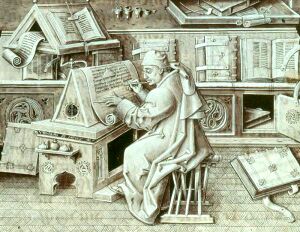
The original manuscripts of the New Testament books are not known to have survived. The autographs are believed to have been lost or destroyed a long time ago. What survives are copies of the original. Generally speaking, these copies were made centuries after the originals from other copies rather than from the autograph. Paleography, a science of dating manuscripts by typological analysis of their scripts, is the most precise and objective means known for determining the age of a manuscript. Script groups belong typologically to their generation; and changes can be noted with great accuracy over relatively short periods of time. Dating of manuscript material by a radiocarbon dating test requires that a small part of the material be destroyed in the process.[21] Both radiocarbon and paleographical dating only give a range of possible dates, and it is still debated just how narrow this range might be. Dates established by radiocarbon dating can present a range of 10 to over 100 years. Similarly, dates established by paleography can present a range of 25 to over 125 years.[22]
Earliest extant manuscripts
The earliest manuscript of a New Testament text is a business-card-sized fragment from the Gospel of John, Rylands Library Papyrus P52, which may be as early as the first half of the 2nd century. The first complete copies of single New Testament books appear around 200, and the earliest complete copy of the New Testament, the Codex Sinaiticus dates to the 4th century.[23] The following table lists the earliest extant manuscript witnesses for the books of the New Testament.
|
Book |
Earliest extant manuscripts |
Date |
Condition |
|
c. 150–300 (2nd–3rd century) |
Large fragments | ||
|
c. 150–250 (2nd–3rd century) |
Large fragments | ||
|
c. 175–250 (2nd–3rd century) |
Large fragments | ||
|
𝔓5, 𝔓6, 𝔓22, 𝔓28, 𝔓39, 𝔓45, 𝔓52, 𝔓66, 𝔓75, 𝔓80, 𝔓90, 𝔓95, 𝔓106 |
c. 125–250 (2nd–3rd century) |
Large fragments | |
|
Early 3rd century[25] |
Large fragments | ||
|
c. 175–225 (2nd–3rd century) |
Fragments | ||
|
c. 175–225 (2nd–3rd century) |
Fragments | ||
|
c. 175–225 (2nd–3rd century) |
Fragments | ||
|
c. 175–225 (2nd–3rd century) |
Fragments | ||
|
c. 175–225 (2nd–3rd century) |
Fragments | ||
|
c. 175–225 (2nd–3rd century) |
Fragments | ||
|
c. 175–225 (2nd–3rd century) |
Fragments | ||
|
c. 175–225 (2nd–3rd century) |
Fragments | ||
|
Early 3rd century |
Fragments | ||
|
c. 350 (4th century) |
Complete | ||
|
c. 350 (4th century) |
Complete | ||
|
c. 200 (late 2nd – early 3rd century) |
Fragment | ||
|
3rd century |
Fragment | ||
|
c. 175–225 (2nd–3rd century) |
Fragments | ||
|
3rd Century |
Fragments | ||
|
c. 300 (late 3rd – early 4th century) |
Fragments | ||
|
c. 300 (late 3rd – early 4th century) |
Fragments | ||
|
3rd century |
Fragment | ||
|
c. 350 (4th century) |
Complete | ||
|
c. 350 (4th century) |
Complete | ||
|
c. 300 (late 3rd – early 4th century) |
Fragments | ||
|
c. 150–250 (2nd–3rd century) |
Fragment |
Textual criticism
Palaeography is the study of ancient writing, and textual criticism is the study of manuscripts in order to reconstruct a probable original or initially copied text.
None of the original documents of the New Testament is known to scholars to be extant; and the existing manuscripts differ from one another. The textual critic seeks to ascertain from the divergent copies which form of the text should be regarded as most conforming to the original.[26] The New Testament has been preserved in three major manuscript traditions: the 4th-century-CE Alexandrian text-type, the Western text-type, and the Byzantine text-type, which includes over 80% of all manuscripts, the majority comparatively very late in the tradition.
Since the mid-19th century, eclecticism, in which there is no a priori bias to a single manuscript, has been the dominant method of editing the Greek text of the New Testament. This is reflected in the Novum Testamentum Graece, which since 2014 corresponds to both the United Bible Society, 5th edition and Nestle-Aland, 28th edition. In textual criticism, eclecticism is the practice of examining a wide number of text witnesses and selecting the variant that seems best. The result of the process is a text with readings drawn from many witnesses. In a purely eclectic approach, no single witness is theoretically favored. Instead, the critic forms opinions about individual witnesses, relying on both external and internal evidence. Even so, the oldest manuscripts, being of the Alexandrian text-type, are the most favored in these two publications; and the critical text has an Alexandrian disposition.[27] Most English translations of the New Testament made in the 20th Century were based on these copies.
Textual scholar Bart D. Ehrman writes: "It is true, of course, that the New Testament is abundantly attested in the manuscripts produced through the ages, but most of these manuscripts are many centuries removed from the originals, and none of them perfectly accurate. They all contain mistakes – altogether many thousands of mistakes. It is not an easy task to reconstruct the original words of the New Testament...."[28] In reference to the textual evidence for the New Testament, Bruce M. Metzger wrote,
In evaluating the significance of these statistics...one should consider, by way of contrast, the number of manuscripts which preserve the text of the ancient classics. Homer's Iliad...is preserved by 457 papyri, 2 uncial manuscripts, and 188 minuscule manuscripts. Among the tragedians the witnesses to Euripides are the most abundant; his extant works are preserved in 54 papyri and 276 parchment manuscripts, almost all of the later dating from the Byzantine period...the time between the composition of the books of the New Testament and the earliest extant copies is relatively brief. Instead of the lapse of a millennium or more, as is the case of not a few classical authors, several papyrus manuscripts of portions of the New Testament are extant which were copies within a century or so after the composition of the original documents.[29][ب]
Biblical scholar Gary Habermas adds,
What is usually meant is that the New Testament has far more manuscript evidence from a far earlier period than other classical works. There are just under 6000 NT manuscripts, with copies of most of the NT dating from just 100 years or so after its writing. Classical sources almost always have fewer than 20 copies each and usually date from 700-1400 years after the composition of the work. In this regard, the classics are not as well attested. While this doesn't guarantee truthfulness, it means that it is much easier to reconstruct the New Testament text. Regarding genre, the Gospels are usually taken today to be examples of Roman biographies.[31]
Every year, several New Testament manuscripts handwritten in the original Greek format are discovered. The latest substantial find was in 2008, when 47 new manuscripts were discovered in Albania; at least 17 of them unknown to Western scholars.[32] There has been an estimate of 400,000 variations among all these manuscripts (from the 2nd to 15th century).[33] If those 400,000 variations are spread over 5,600 manuscripts, the average manuscript has only about 71 variations, although some of these manuscripts are the equivalent of several hundred pages of text, hand-written (see Codex Vaticanus, Codex Alexandrinus, et al.). The number of variants is additionally less significant than may appear since it is a comparison across linguistic boundaries. More important estimates focus on comparing texts within languages. Those variations are considerably fewer. The vast majority of these are accidental errors made by scribes, and are easily identified as such: an omitted word, a duplicate line, a misspelling, a rearrangement of words. Some variations involve apparently intentional changes, which often make more difficult a determination of whether they were corrections from better exemplars, harmonizations between readings, or ideologically motivated.[34] Variants are listed in critical editions of the text, the most important of which is the Novum Testamentum Graece, which is the basis for most modern translations. For over 250 years, Christian scholars have argued that no textual variant affects key Christian doctrine.[35][36]
Listings
- List of New Testament papyri
- List of New Testament uncials
- List of New Testament minuscules
- List of New Testament lectionaries
- List of New Testament Latin manuscripts
Gallery
Fragments of the Dead Sea scrolls on display at the Archeological Museum, Amman
𝔓52 is the oldest known manuscript fragment of the New Testament, containing a portion of the Gospel of John
𝔓46 is the earliest (nearly) complete manuscript of the Epistles written by Paul in the new testament.
𝔓37 is a fragment of the Gospel of Matthew containing nomina sacra.
𝔓1 is an early third century fragment of the Gospel of Matthew.
Codex Sinaiticus (c. 350) contains the oldest complete copy of the New Testament, as well as most of the Greek Old Testament, known as the Septuagint
Codex Vaticanus Graecus 1209 is one of the best available Greek manuscripts of almost the entire bible.
P. Chester Beatty VI showing portions of Deuteronomy
Uncial 0308 is a fragment of the Book of Revelation.
The first page of the Gothic language Codex Argenteus
Folio 5r of the Codex Amiatinus, manuscript of Vulgate
انظر أيضاً
- Ancient literature
- Apographa
- Dating the Bible
- Biblical criticism
- Textual criticism
- Categories of New Testament manuscripts
- List of major textual variants in the New Testament
- Higher criticism
- Manuscript culture
- Nag Hammadi library
- Fifty Bibles of Constantine
- List of Hebrew Bible manuscripts
- List of illuminated manuscripts
ملاحظات
- ^ A manuscript is abbreviated MS for singular and MSS for plural.
- ^ As a footnote to his comments, Metzger also said, "Lest, however, the wrong impression be conveyed from the statistics given above regarding the total number of Greek manuscripts of the New Testament, it should be pointed out that most of the papyri are relatively fragmentary and that only about fifty manuscripts (of which the Codex Sinaiticus is the only Uncial manuscript) contain the entire New Testament."[30]
المراجع
- ^ Barkay et al. 2004.
- ^ "Codex Sinaiticus". Codex Sinaiticus Website. Archived from the original on 2008-12-31. Retrieved 2008-12-31.
- ^ Aland & Aland 1995, p. 81.
- ^ Story, J. Lyle (2018-07-25). "Greek NT Scribe – Job Description". Greek to Me. Retrieved 2018-07-25.
- ^ "Seid". Retrieved 2014-10-04.
- ^ Metzger & Ehrman 2005, pp. 3gf.
- ^ "Waltz". Retrieved 2014-10-04.
- ^ Metzger & Ehrman 2005, pp. 3–10.
- ^ Aland & Aland 1995, p. 77.
- ^ "Seid". Retrieved 2014-10-04.
- ^ Kruger 2012, p. 249.
- ^ Kruger 2012, p. 250.
- ^ Elliott, J.K. (1996). "Manuscripts, the Codex, and the Canon". Journal for the Study of the New Testament. 19 (63): 111. doi:10.1177/0142064X9701906306. S2CID 162215529.
- ^ Metzger & Ehrman 2005, pp. 17–18, 20.
- ^ أ ب Aland & Aland 1995, p. 72.
- ^ von Soden 1902.
- ^ أ ب Aland & Aland 1995.
- ^ New Testament Virtual Manuscript Room Archived 2018-02-20 at the Wayback Machine at the University of Münster website
- ^ Aland & Aland 1995, p. 73.
- ^ Nestle-Aland Novum Testamentum Graece, pp. 64*–76*.
- ^ "Britannica Online: Types of manuscript errors". Retrieved 2021-06-30.
- ^ Greifenhagen, F. V. (2002). Egypt on the Pentateuch's Ideological Map. London: Sheffield Academic Press. ISBN 0-8264-6211-1.
- ^ Ehrman 2004, pp. 479–480.
- ^ أ ب Willker, Wieland (2008-04-17). "Complete List of Greek NT Papyri". Archived from the original on 2014-03-12.
- ^ Comfort & Barrett 2001, p. 65.
- ^ Metzger 1992.
- ^ Aland & Delobel 1994, p. 138.
- ^ Ehrman 2004, p. 449.
- ^ Metzger 1992, pp. 33–35.
- ^ Metzger 1992, p. 34.
- ^ "The Reliability and Inspiration of the Bible". Dr. Habermas Answers Important Questions.
- ^ Vu, Michelle A (2008-04-21). "NT scholar on discovery of giant trove of Bible manuscripts". Christianity Today.
- ^ Wallace, Daniel (2009-04-13). "The Number of Textual Variants: An Evangelical Miscalculation".
- ^ Ehrman 2004.
- ^ Wallace, Daniel (2004-06-03). "The Majority Text and the Original Text: Are They Identical?". Retrieved 2013-11-23.
- ^ c.f. Bruce, F.F. "Are the New Testament Documents Reliable?"
ببليوگرافيا
- Aland, Kurt; Aland, Barbara (1995). The Text of The New Testament: An Introduction to the Critical Editions and to the Theory and Practice of Modern Textual Criticism. Translated by Erroll F. Rhodes (2nd ed.). Grand Rapids, MI: Wm. B. Eerdmans Publishing Company. pp. 40f, 72f. ISBN 0-8028-4098-1.
- Aland, Barbara; Delobel, Joël (1994). New Testament textual criticism, exegesis and church history: a discussion of methods. Kampen: Kok Pharos. ISBN 9-03-900105-7.
- Barkay, G.; Vaughn, A.G.; Lundberg, M.J.; Zuckerman, B. (2004). The Amulets from Ketef Hinnom: A New Edition and Evaluation. Vol. 334. pp. 41–71.
An innovation in the report was the simultaneous publication of an accompanying "digital article," a CD version of the article and the images
{{cite book}}:|work=ignored (help) - Bruce, F. F. (1964). "The Last Thirty Years". In Frederic G. Kenyon (ed.). Story of the Bible. Retrieved 2007-06-19.
- Bruce, F. F. (2003). The New Testament Documents: Are They Reliable?. ISBN 978-0802822192.
- Comfort, Philip W.; Barrett, David P. (2001). The Text of the Earliest New Testament Greek Manuscripts. Wheaton, Illinois: Tyndale House. ISBN 0-8423-5265-1.
- Ehrman, Bart D. (2004). The New Testament: A Historical Introduction to the Early Christian Writings. New York: Oxford. pp. 480f. ISBN 0-19-515462-2.
- Kruger, Michael J. (2012). Canon revisited : establishing the origins and authority of the New Testament books (1st ed.). Wheaton, Ill.: Crossway. ISBN 9781433505003.
- Metzger, Bruce M. (1992). The Text of the New Testament: Its Transmission, Corruption and Restoration (3rd ed.). Oxford University Press. ISBN 0-19-507297-9.
- Metzger, Bruce M.; Ehrman, Bart D. (2005). The Text of the New Testament: Its Transmission, Corruption and Restoration (4th ed.). Oxford University Press. ISBN 0-19-516667-1.
- Nestle-Aland Novum Testamentum Graece. Vol. 27. Hendrickson Publishers. 2006. ISBN 1-59856-172-3.
- Seid, Timothy W. "Interpreting Ancient Manuscripts". Interpreting Ancient Manuscripts Web. Retrieved 2021-04-07.
- Waltz, Robert. "An Introduction to New Testament Textual Criticism". A Site Inspired By: The Encyclopedia of New Testament Textual Criticism. Archived from the original on 2007-06-18. Retrieved 2007-06-19.
- von Soden, Hermann (1902). Die Schriften des Neuen Testaments, in ihrer ältesten erreichbaren Textgestalt hergestellt auf Grund ihrer Textgeschichte (in الألمانية). Berlin: Glaue.
4 vols., 1902–1910
- Wilson, Robert Dick (1929). The Textual Criticism of the Old Testament. Vol. 27. p. 40.
{{cite book}}:|work=ignored (help)
وصلات خارجية
- Center for the Study of New Testament Manuscripts
- Michael D. Marlowe's Bible Research site
- Micheal W. Palmer's Greek-Language.com Manuscripts page
- TextCrit.com: Eusebian Canon in Codex A
- Fragment of Psalms at the Heidelberger Papyrus-Sammlung
 [[wikisource:Catholic Encyclopedia (1913)/Manuscripts of the Bible "|Manuscripts of the Bible]"]. Catholic Encyclopedia. New York: Robert Appleton Company. 1913.
[[wikisource:Catholic Encyclopedia (1913)/Manuscripts of the Bible "|Manuscripts of the Bible]"]. Catholic Encyclopedia. New York: Robert Appleton Company. 1913. {{cite encyclopedia}}: Check|url=value (help)- Contantinus Siamakis, Oldest Manuscript of the Bible
- Short description is different from Wikidata
- Articles with hatnote templates targeting a nonexistent page
- Articles with unsourced statements from January 2019
- Articles with unsourced statements from August 2022
- CS1 errors: periodical ignored
- CS1 الألمانية-language sources (de)
- CS1 errors: URL
- Biblical manuscripts
- Scribes
- Textual scholarship


